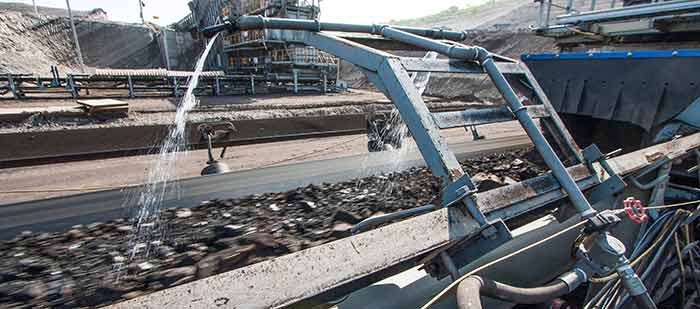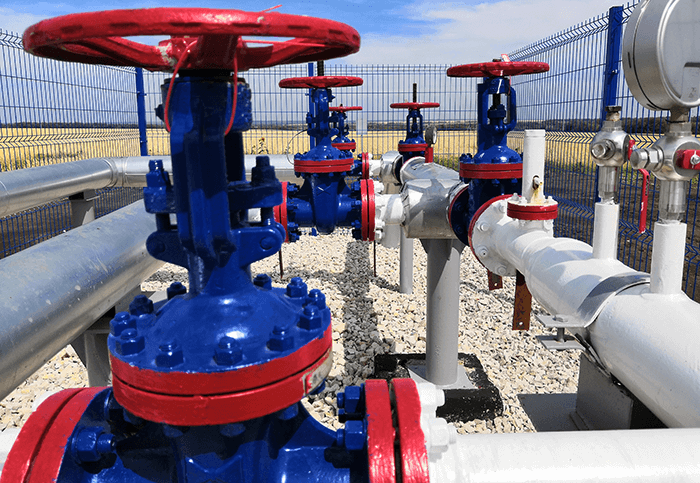When a foreman calls a company and says, “I need a pump for my mine,” what comes to mind first? What kind of pump does the end user need? Is it slurry, submersible sump, gland water, metering, plant water supply, dewatering, a dust suppression pump or a booster pump? Obviously, there are many pump applications on nearly every mine site, and it will take homework to select the right one.

Image 1. This is one type of conveyance dust suppression system that is used during the coal mining process to control respirable coal and rock dust. (Images courtesy of Motion Industries)
There are several key factors to consider when selecting a pump for mine dewatering. First, determine the static head that needs to be overcome. If the pump cannot produce enough pressure to overcome the vertical distance, the needed flow will not be achieved.
Second, what flow is needed to properly remove the amount of water in order to keep the mine dry, and what style of pump is most suited for the application? Would it be a self-priming, submersible or a vertical turbine? If self-priming, what is the length of suction line? This determines the friction loss and the height that can be pulled with a suction lift. The size and type of material of the suction line will need to be identified. The size of the suction line must be equal to or greater than the size of the suction or inlet port. This helps reduce the possibility of suction cavitation. The size, length and type of material of the discharge line must be taken into account, as well. All of these items factor into the total dynamic head, which is an important part of proper pump selection.
Another important factor is the consideration of any solids in the water, as this decides what style of impeller and what strainer size to use
If it is an underground mining application, determine if this is a Mining Safety and Health Association (MSHA) application. All equipment going into those locations must meet strict criteria for the protection of those working in that environment. System designers must ensure that all of the equipment going into these areas conforms to MSHA standards and requirements.
Most underground dewatering applications use submersible pumps, due to their easy mobility and quick lead times from the factories. There are, however, potential hazards to the ease of changing out submersible pumps.
It is common for a miner to go to the storeroom or warehouse for a replacement pump and grab a pump that is the “required” horsepower (hp). If they have not checked to see if it is a high head (higher pressure) or high flow variation, or worse yet, getting a pump that is not MSHA approved and placing in it an explosive environment—the results can be devastating.
If it is the wrong style, the operator can burn up or deadhead the pump. Either way, this results in lack of performance, which is costly. Quite often, pumps end up lying on the side, covered halfway with a slurry the consistency of pudding, the strainer partially exposed to air—shortening the pump’s life and wasting time and money. The proper placement of the pump is just as important as the proper pump selection.
Users must be careful to select the correct voltage motor and control panel, as many of the pumps are single voltage, not dual voltage. Pump suspension is important so mud and debris are not pulled into the pump, starving the pump for water. At the same time, it needs enough submergence to keep the motor cooled properly and not create a vortex, which will pull air into the pump. It is also helpful to use a control system to keep the pump from running dry. If solids are present, consider using a vortex impeller and other materials of abrasive-resistant construction if the solids are abrasive.
Using a submersible turbine is an efficient way to dewater, as long as the water is free of solids. Be sure the control panel complies with all required certifications. Many submersible turbines are of 304 SST or a polyresin construction, so low pH is not a factor for them. They also have good mechanical efficiencies with a low upfront cost. The downside is that they have to be installed in a well or a cooling sleeve to promote proper motor protection. If they are not installed in a sleeve, the pump may not have adequate cooling for the motor. This will cause premature motor failure.
Let’s have another look at self-priming centrifugal pumps, or self-primers, for aboveground dewatering. Common usage would be surface-mining operations (or large-scale underground mining applications) where there are no issues with ventilation. This style of pump can handle various size solids and produce higher flow.
The downside is that they are not as efficient, which causes them to be more costly to run, and they are limited in terms of suction lift.
In real terms, when exceeding about 20 feet of suction lift, the pump performance is greatly affected; therefore, proper pump selection and placement is critical.

